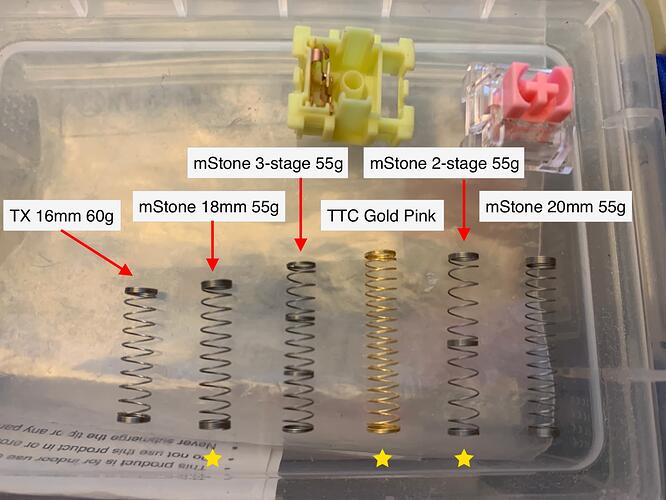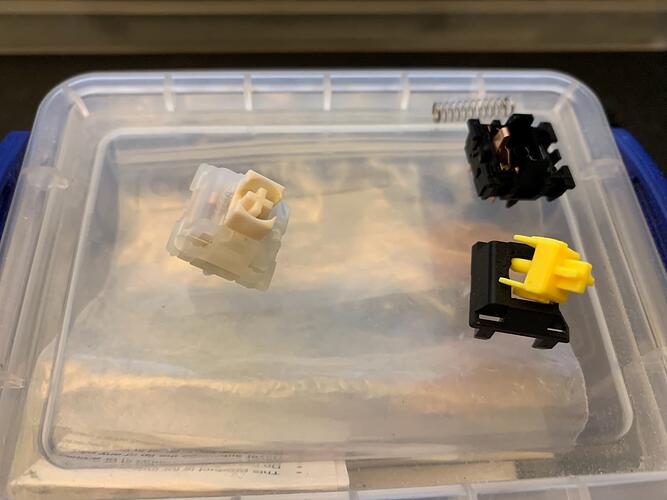If you start pressing with finger at least 1cm above the keycap, long springs are easier to recognize.
16mm springs is my personal favorite as well, it adds just enough preload compared to the typical 14-15mm spring and makes sub 65g spring weights feel better for sustained typing for me. At the same time its not an excessive amount of preload to the point where I’m constantly forced to bottom out with both linears and tactiles (Durock Medium Tactile and Light Tactiles).
I have 17.5mm springs from Swagkeys (the 62g “Chewy” ) and I think those have just a little too much preload for that all or nothing feel. The two stage stuff seems fun to use but I’m not a fan of switches that essentially become on/off light switches; at that point I might as well be typing on the functional equivalent of a rubber dome.
I liked TTC Gold Pink’s chewy feel but wanted a slightly heavier so tried some mStone springs from KPRepublic, mainly for wide variety of spring types at same weight. TX long (16mm) is what I’m currently using in most of my boards so included it in this photo as reference point.
As replacement for TTC Gold Pink, two winners:
- mStone 2-stage 55g - chewy like TTC Gold Pink, slightly heavier top weight
- mStone 18mm 55g - chewy like TX 16mm 60g, slightly heavier top weight
Two are close but differs slightly in how it’s chewy. 18mm is slightly heavier at top than 2-stage but the later is more bouncy at the bottom, making it closer to TTC Gold Pink. Because of heavier top weight, 18mm will feel more speedy or shorter in key travel and bottom out more loudly, making it more appropriate for great sounding switches like Cherry black. TTC Gold Pink is loud and decently nice sounding but not at the Cherry black level (in my mind) so 2-stage makes more sense.
Both mStone 3-stage and 20mm felt tad too heavy at top for prolonged use but are promising enough to try them again at lower weight.
NOTE: Since these springs don’t come with spring top weight, I went with 55g bottom-out weight to get a good feel for how these irregular springs differ. Too early to generalize nor expect linear dynamics but, for at least 18mm and two-stage, reducing usual bottom-out by 5g is a good start. For 3-stage and 20mm, I’d reduce by 7~10g.
DISCLAIMER: I could be wrong and have been wrong countless times (lost count out of self-interest) so take a basketball sized grain of salt before bed and don’t call me in the morning.
Wonder if those ~55 G mStone springs might be good for addressing some of the issues with U4 Boba at lower weights.
Boba can be a bit sluggish on the return at 55 G regular 15mm linear, but with greater top weight while still having low bottom-out weight, might help to clear the tactile bump easier.
57 G Long [16mm] is currently maybe a minimum good weight for U4 Boba, but some of these mStone springs might allow you to take it reliably down to 55 G.
Good question. I don’t have U4 Boba so can’t answer. Would be neat if Spring Clinic of sort were part of every keyboard meetups because finding the right spring is a tedious and wasteful process.
So here’s an interesting thing that was brought up in a recent thread:
The TLDR of this is that Gateron switch housings appear to preload the spring to a shorter height than a Cherry or JWK switch does, resulting in the effective weight of a spring installed in a Gateron switch being reduced. I highly recommend reading both the embedded posts by Pylon because he has the actual measurements to verify this and goes into more detail.
This would also appear to explain why TX Keyboards had this chart for their spring selection which said a spring is effectively lighter in a Gateron switch than it is in the Cherry switch.

Quite a surprise there. Gonna try my tad heavy springs in Gateron switches to see if they feel better.
UPDATE: Tried TTC Hey stem and spring in Gateron KS-3 X-1 Pro housing and the spring does feel weaker at top. Taking away extra weight off the top makes the switch feel less interesting but better than having switches sit unused. At least milky-shrouded looks pretty good.
UPDATE2: Sounds bad though. Urgh.
In an attempt to go outside my box a bit, I’m trying 15mm TX mediums in a slightly heavier weight than my typical 55g in Longs. I gave Durock’s long and two-stage springs a try but I ran into the same issues as with the Kinetic Labs symmetrics: a slight friction shuffling sound that I just couldn’t get rid of on compression. The solution would probably be heaps of lube, but that’s just impractical.
What I’m hoping is that the mediums are slightly lighter at the top but are more linear in their buildup. We’ll see!
Not if you use Superlube’s synthetic oil with PTFE instead of Krytox oil ![]()
The viscosity grade of their oil is 118 cST @ 40c, which is slightly less viscous than GPL105 is @ 40c (160 cST). I would use 20c measurements for comparison but the Superlube datasheets don’t include that unfortunately. For something like springs I find its better to just douse em in oil liberally instead if bag lubing. A 4oz bottle (Superlube 51004) costs about $6-10 depending on your vendor.
I pretty much stopped using GPL105 in favor of this, with no difference in spring ping or crunch.
Early in-use feedback on mStone 55g springs.
Despite initial impression, I chose to use 18mm and 20mm single-stage springs in two boards. Used 18mm with TTC Gold Pink and 20mm with Hyperglides. In switch tester, 20mm felt tad heavy but not in-use. Both feel really good, arguably more lively than my usual go to spring: 60g TX 16mm.
I punted on two-stage and three-stage springs this round because, when I tried them on a single row, they felt less lively than 18mm and 20mm. That said, I’m no longer sure what role switch housing played.
Some mysteries:
- 20mm lowered pitch slightly, making me wonder if added pressure against top housing due to pre-load may have caused the change.
- 20mm and three-stage springs initially felt tad heavy. They don’t in-use.
I also had this thought, BOX Navies are lower pitched than BOX Jades despite having only one difference, the spring.
spring weight definitely makes a difference. I swapped some 30g sprits into my choc robins (50g or so stock) and they got significantly higher pitched. Really interesting.
I used mStone 55g two-stage springs in a Cherry black board and, like before, what seemed tad heavy in switch tester felt just fine in-use. Two-stage springs made the switch feel more bouncy which I liked. I suspect three-stage is similar but will defer judgement until I can try them in-use.
So, if you’re comfortable with TX 60g long (16mm), 55g two-stage should be fine.
What I can’t figure out is how “stage” springs are supposed to make a difference? Couldn’t you achieve the same thing by simply increasing the length of the spring or tightness of the coils? Maybe the “stage” aspect (tightly coiled like on the ends of traditional springs) is more for structural integrity. I have noticed that longboi springs tend to malform a lot easier while I’m building with them.
for realsies? Daaaamn… thanks for the info. I’m greatful for this insight.
I have found that the stage springs (well, the 2 stage 63.5 Tecsee springs anyway) do feel different. I feel a swell of force in the middle of the press while typing. I had a friend try a switch with a two stage spring, totally blind (by testing standards that is), and he thought that it had similarities to a tactile switch as he felt the same thing. Don’t get me wrong, they still feel like linears, and maybe it is due to my exact particular setup, but they do feel different to me.
but you aren’t implying that you feel light and then strong and then light again, right? Because that’s got to be physically impossible due to the way springs work. Are you saying that you feel light and then quickly heavier as the press goes down?
This has been my perception so far; long springs seem to chatter against the housing less when they have tighter coil sections - but that’s definitely an un-scientific impression from me at the moment.
No, I don’t mean that the force is more in the middle of the press than at the bottom. I think I perceive the most drastic change in force in the middle of the press. I also notice it as much when pressing really slowly. I have to put this spring in multiple switches as well, as they are only in TTC Wilds right now – I’m not sure what is the larger contributing factor here.
Fuzzy on theory but it’s easy enough to see how they behave differently under pressure, using a thin stick to prevent the spring from buckling. With 3-stage spring, outer stages compress faster than inner stage, meaning coil gaps in the middle stage is wider than top and bottom stages.

